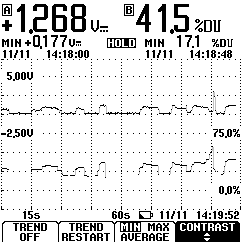
DifferentialPressureFeedbackExhaust Sensor
(Ceramic capacitive pressure transducer)
Here is some insight on Ford's DPFE sensor. These things will get a lot of attention, mainly because they get pounded with exhaust emissions continuously. Moisture contamination, and exhaust heat will be the death of these things, it corrodes the sensor inside and destroys the seals around the pressure sensing ceramic disc.

96 Ford Ranger 3.0 V6 74k miles.Top trace is DPFE signal to PCM, voltage increases with higher pressure. Bottom trace is EVR signal from PCM. EVR, will change with DPFE, to control EGR flow. Engine loaded about 1200 RPM.

This DPFE plot is from the same 96 Ford Ranger. The top trace is the DPFE signal,voltage output to PCM reacting to pressure drop across metering orifice in the EGR supply tube. The bottom trace is the duty cycle signal from the PCM to the EVR solenoid. This plot recorded before DPFE sensor replacement.

Here's the plot recorded after sensor was replaced, idle signal (min volts) is back where it should be and stayed consistent. Idle signal on bad sensor started out at .450v cold, and dropped to .177v hot. Internal seal on pressure sensing disc was leaking due to corrosion around sealing surface of sensor housing. Caused intermittent code. Positive pressure sends higher voltage to PCM allowing more EGR flow by adjusting duty cycle on EVR solenoid.

These are the voltage readings with two different pressures applied at the ref port on the DPFE sensor. Since this port looks at the exhaust pressure ahead of the catalytic convertor, it would be a quick way to verify a plugged cat, about 1 volt per PSI.